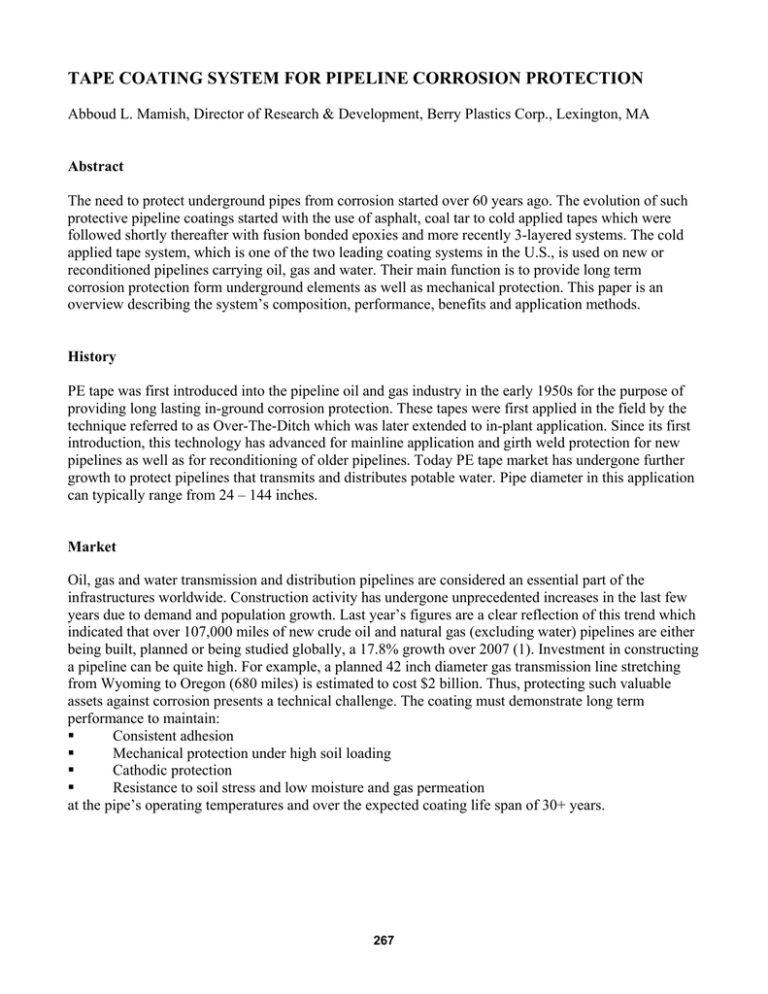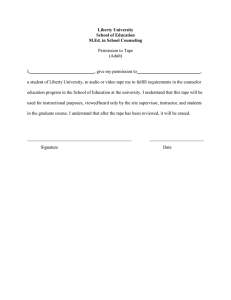TAPE COATING SYSTEM FOR PIPELINE CORROSION PROTECTION
advertisement

TAPE COATING SYSTEM FOR PIPELINE CORROSION PROTECTION Abboud L. Mamish, Director of Research & Development, Berry Plastics Corp., Lexington, MA Abstract The need to protect underground pipes from corrosion started over 60 years ago. The evolution of such protective pipeline coatings started with the use of asphalt, coal tar to cold applied tapes which were followed shortly thereafter with fusion bonded epoxies and more recently 3-layered systems. The cold applied tape system, which is one of the two leading coating systems in the U.S., is used on new or reconditioned pipelines carrying oil, gas and water. Their main function is to provide long term corrosion protection form underground elements as well as mechanical protection. This paper is an overview describing the system’s composition, performance, benefits and application methods. History PE tape was first introduced into the pipeline oil and gas industry in the early 1950s for the purpose of providing long lasting in-ground corrosion protection. These tapes were first applied in the field by the technique referred to as Over-The-Ditch which was later extended to in-plant application. Since its first introduction, this technology has advanced for mainline application and girth weld protection for new pipelines as well as for reconditioning of older pipelines. Today PE tape market has undergone further growth to protect pipelines that transmits and distributes potable water. Pipe diameter in this application can typically range from 24 – 144 inches. Market Oil, gas and water transmission and distribution pipelines are considered an essential part of the infrastructures worldwide. Construction activity has undergone unprecedented increases in the last few years due to demand and population growth. Last year’s figures are a clear reflection of this trend which indicated that over 107,000 miles of new crude oil and natural gas (excluding water) pipelines are either being built, planned or being studied globally, a 17.8% growth over 2007 (1). Investment in constructing a pipeline can be quite high. For example, a planned 42 inch diameter gas transmission line stretching from Wyoming to Oregon (680 miles) is estimated to cost $2 billion. Thus, protecting such valuable assets against corrosion presents a technical challenge. The coating must demonstrate long term performance to maintain: ! Consistent adhesion ! Mechanical protection under high soil loading ! Cathodic protection ! Resistance to soil stress and low moisture and gas permeation at the pipe’s operating temperatures and over the expected coating life span of 30+ years. 267 Coating Types There are many coating types that are employed in corrosion protection of steel pipes. This protection can be broken down into 2 areas. First, main line coating where this coating is applied to every pipe section with the exception of the last 6” of both ends and second, girth weld where the pipe ends are coated in the field and after the pipe joints are welded. Main line coating types include: ! Cold applied tapes ! Fused tapes ! Fusion bonded epoxy ! 2 part Urethane ! 2 and 3 layer Polyethylene Girth weld coating types include: ! Shrink Sleeves ! Cold applied tapes ! 2 part liquid epoxy System Composition and Function The total tape system components consist of a primer applied directly to the pipe surface, an inner-wrap tape layer that provides a corrosion barrier and an outer-wrap tape layer that provides mechanical protection (Figure 1). 1. Primer The primer is an integral part of the cold applied tape system. It is mainly composed of butyl rubber along with tackifiers, stress corrosion inhibitors and other additives that will facilitate good adhesion to the blasted pipe surface as well as maximize bonding of the inner-wrap tape layer to the pipe. These components are typically dispersed in a high evaporating solvent matrix and sprayed at controlled thickness on the blasted pipe surface, allowed to adequately dry prior to the application of the innerwrap tape layer. Due to recent state and federal regulations mandating solvent emission controls, 100% solids hot melt adhesive “primers” have been developed and introduced recently to the market as an alternate solution. They are also formulated with a butyl rubber and applied to the pipe surface using more specialized spray equipment. 2. Backing The inner and outer wrap layers backings are primarily composed of Polyethylene (PE). The PE backing is formulated to the demands of the coating for a specific application on pipe, or for a specific application as a coating. The PE composition of the anti- corrosion layer product is different than the mechanical layer, due to the function of the respective layers. The anti-corrosion layer generally has more medium and low density PE composition which provide strength and conformability, while mechanical layers require the use of select high and low density PE that provide higher mechanical strength, toughness and resistance to stress cracking. A typical formula would include low and high density PE, antioxidants, UV inhibitor and colorant. 268 3. Adhesive The adhesive in both tape layers are elastomeric based. Butyl rubber (BR) is predominantly used as opposed to other elastomers. BR’s molecular structure of low unsaturation levels yields unique characteristics of chemical and moisture resistance, thermal stability, weathering and gas permeability, all essential properties required for long term in-ground performance. In addition to BR, a typical formula would include a tackifier, oil, filler, antioxidant, biocide and a colorant. Cross-linkers may also be used in applications requiring high, long term resistance to excessive soil stress and continuous heat exposure (up to 125 °C). The adhesive works in conjunction with the primer to form a strong bond to the steel substrate, providing the corrosion protection and long term performance that the pipe requires as well as imparting high cathodic disbonding resistance, high shear and soil stress resistance. Different adhesive formulas are used depending on the surface to be applied to. There is the steel pipe surface and the PE backing layer of the anti-corrosion layer and the backing layer of the mechanical layer. Each layer of the PE Tape system must have a specific adhesive composition to insure achievement of a good adhesion at each interface. Cold Applied Tape System Primer Inner-wrap Outer-wrap Figure 1. Manufacturing Processes PE backings are manufactured by either a Calendering or Co-extrusion process whereby, the Polyethylene resins with additives are blended and processed to form a PE sheet or film. The calendering process by the nature of the methodology orients the molecular chains of the Polyethylene to provide some machine direction orientation of the PE film. This orientation provides some unique application advantages relative to the yield point of the PE film when stressed and stretched during application on pipe. Co-extrusion on the other hand does not impart the same degree of orientation, resulting in different tensile properties requiring different application parameters during application on pipe. After the application of the adhesive to the PE backing or film, the product is rolled into master rolls, slit to width and packaged as required by in-use application in the industry. 269 Tape Application to Pipe The pipe coating process consists of the following steps, (Figure 2): ! Drying and cleaning using a grit or sand blasting to remove mil scale ! Phosphoric acid wash and drying, if required ! Primer spray and drying ! Inner-wrap application continuously and spirally using precision tension control ! Outer-wrap application continuously and spirally using precision tension control ! Holiday Detection ! Cut backs at both pipe ends Multilayer PE Tape Application – Plant Coating Grit Blasting Primer Spray Pin Hole Detection 2 Layer Tape Application Figure 2. The above steps are carried out using detailed specifics to conform to industry and tape manufacturer application standards under the watchful eyes of a certified inspector. For example, the sand blasting step requires achieving a well defined cleanliness and anchor pattern for the primer/inner-wrap to achieve expected adhesion, primer dryness and thickness, tape tension, temperature and overlap control are among many application conditions that are required to be practiced. Both tape layers are applied with recommended tension to insure good application to the pipe, to insure good conformability at the overlap and to achieve the mechanical and chemical adhesion of the coating system to the pipe. With machine application using tension, the coating experiences tension and necking down of the coatings by < 2%. This tension effect creates a “gasket effect” or flow of the adhesive at the overlap sealing the adhesive to the overlap and further creating mechanical adhesion of the coating to the substrate and to the multiple interfaces within the PE tape coating system. Some of the industry standards include DIN 30672, EN 12068, AWWA C-209, C-214 and C-225. Performance Requirements and Testing Methods As stated above, the expectation that the system is required to perform at and long term in-ground performance, 30+ years, are quite demanding. Thus, design parameters, functionality long term heat aging and in-ground testing and exposure to the most corrosive soil environment is the first critical stage of development prior to any new product launch. 270 First, the inner-wrap must form a continuous and permanent bond to the primer providing adhesion, soil stress and resistance to cathodic disbondment as well as bond to itself at the overlap regions. Second, the outer-wrap must bond to the inner-wrap and to itself, provide mechanical strength to resist damage during shipping, handling backfilling and long term rock penetration damage under load. Other requirements include UV exposure of coated pipes during yard storage, low temperature flexibility down to -40 °C and good ductility and flexibility during bending over a wide temperature range. Table 1 is an example of some of the critical properties for the inner wrap tape layer. Table 1: Physical Properties of an Inner-Wrap Tape, (2) ___________________________________________________________________ Property Requirement ___________________________________________________________________ Width deviation - 5% of width or - ¼”, whichever is smaller Thickness 19-22 mils Adhesion (with Primer) 200 oz/in Water Absorption (24 hrs.) 0.2 %, maximum Water vapor transmission 0.2 perm [1.15x10-11 kg/(Pa.s.m2)] maximum Dielectric Strength 6000 volts/tape thickness Insulation resistance 500,000 megaohms Tensile Strength 20 lb/in % Elongation 100 minimum Non-polyolefinic content 3.5% maximum Field Installation PE tape coating systems for pipe reconditioning are applied using traditional “Line Travel” or Over-TheDitch techniques which are strictly field applied methods. This method is less used today than in the 1960-1990s. For new pipe construction, the plant coated pipes are transported to the installation site where the 40’ joint sections are first welded, followed by sand blasting the cut back area to the proper anchor profile and then either hand wrapped with tape or a shrink sleeve is applied prior to burial on a specified backfill (pea stone/sand mix). Here again these steps are carried out taking special care to avoid coating damage that may go unnoticed or require repair that would slow down the construction progress. References 1) Beaubouef, B., Pipeline and Gas Technology Journal, page 16, (May 2008). 2) ANSI/AWWA C-214-07 standard,” Tape Coating System for the Exterior of Steel Water Pipelines.” 271 TECH 32 Technical Seminar Speaker Tape Coating System for Pipeline Corrosion Protection Abboud L. Mamish, Berry Plastics Corp. Abboud L. Mamish is director of research & development at Berry Plastics Corporation and Subsidiaries. He has 28 years of experience in research and new product development in various PSA tape applications such as automotive, corrosion protection and industrial. Mamish holds nine US patents and has published four technical papers. Mamish has both a B.S. and M.S. in plastics engineering from the University of Massachusetts Lowell. His master’s thesis was “Co-extrusion Coating of Woven Fabrics.” He can be reached at abboudmamish@berryplastics.com. 265

